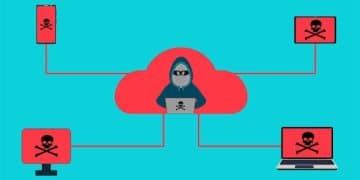AI-Powered Cyberattacks: New Cybersecurity Threats in the US

The new cybersecurity threat landscape in the US is increasingly defined by AI-powered attacks, which are evolving rapidly and becoming more sophisticated, targeting critical infrastructures and sensitive data with unprecedented precision and scale.
The digital battlefield is shifting. The old cybersecurity defenses are no longer enough. The new cybersecurity threat landscape: how AI-powered attacks are evolving in the US, demands a new, proactive approach.
Understanding the Emerging AI Cybersecurity Threat Landscape
The rise of artificial intelligence (AI) has brought about transformative changes across various sectors, but it has also opened new avenues for malicious actors in the realm of cybersecurity. Understanding the new landscape is crucial for organizations and individuals alike.
The Dual-edged Sword of AI in Cybersecurity
AI is not just a tool for defense; it’s also a weapon in the hands of attackers. AI algorithms can automate and accelerate the process of finding vulnerabilities, crafting phishing campaigns, and even evading detection.
The Speed and Scale of AI-Driven Attacks
Traditional cybersecurity measures often struggle to keep up with the speed and scale of AI-driven attacks. Manual analysis and response times are simply too slow to effectively counter these threats.
- Automated Vulnerability Scanning: AI can scan vast networks and systems for vulnerabilities much faster than humans.
- Sophisticated Phishing Campaigns: AI can personalize phishing emails to make them more convincing.
- Evasion of Detection: AI can learn to evade traditional security measures by adapting its attack patterns.
Organizations need to understand that this new landscape demands a shift in their security posture. They need to adopt AI-powered defense systems to effectively counter these threats.

The evolving threat landscape necessitates a more proactive and adaptive approach to cybersecurity.
The Anatomy of AI-Powered Cyberattacks
AI-powered cyberattacks come in various forms, each exploiting different vulnerabilities and using AI in unique ways. Understanding the anatomy of these attacks is key to developing effective defenses.
AI-Enhanced Phishing
Phishing attacks have been around for years, but AI makes them much more effective. AI can analyze user data to craft highly personalized phishing emails that are more likely to trick victims into revealing sensitive information.
AI-Driven Malware
Malware is also becoming more sophisticated thanks to AI. AI can be used to create malware that can adapt to its environment and evade detection.
- Deepfakes: AI can create realistic fake videos or audio recordings to impersonate individuals.
- Polymorphic Malware: AI can generate constantly changing malware code to evade signature-based detection.
- Zero-day Exploits: AI can discover and exploit previously unknown vulnerabilities in software.
By understanding how AI is used in these attacks, organizations can develop more effective defenses and protect themselves and their customers from harm.
Detecting AI-driven threats requires advanced tools and expertise.
Protecting Against the New Cybersecurity Threat Landscape
Protecting against the new cybersecurity threat landscape requires a multi-layered approach that incorporates AI-powered defenses, employee training, and proactive threat hunting.
Implementing AI-Driven Security Solutions
AI-driven security solutions can help organizations detect and respond to threats much faster than traditional methods.
The Human Element: Training and Awareness
Employee training and awareness are also crucial. Employees need to be able to recognize phishing emails and other social engineering attempts.
- AI-Powered Threat Detection: These systems can analyze network traffic and system logs to identify anomalous behavior.
- AI-Driven Incident Response: AI can automate incident response tasks, such as isolating infected systems and containing the spread of malware.
- Regular Security Audits: Organizations should conduct regular security audits to identify vulnerabilities and weaknesses in their systems.
Security is everyone’s responsibility and the whole organization must have the right mindset.

A proactive approach to cybersecurity is essential in the face of evolving AI-powered threats.
The Role of Government and Industry Collaboration
The battle against AI-powered cyberattacks cannot be fought alone. Government and industry collaboration is essential to sharing threat intelligence, developing best practices, and establishing regulatory frameworks.
Information Sharing and Threat Intelligence
Sharing threat intelligence is crucial for staying ahead of attackers. Government agencies and industry organizations can work together to share information about new threats and vulnerabilities.
Developing Best Practices and Standards
Developing best practices and standards is also important. This can help organizations implement effective security measures and ensure that their systems are protected.
- Government Regulations: Government regulations can help ensure that organizations are implementing adequate security measures.
- Industry Standards: Industry standards can provide a framework for developing and implementing best practices.
- Public-Private Partnerships: Public-private partnerships can facilitate information sharing and collaboration between government and industry.
Working together, government and industry can create a more secure digital environment for everyone.
Collaboration is key to staying ahead of AI-powered cyber threats.
Future Trends in AI and Cybersecurity
AI will continue to play an increasingly important role in both offensive and defensive cybersecurity strategies. Understanding future trends is essential for staying ahead of the curve.
The Rise of Autonomous Security Systems
Autonomous security systems that can automatically detect and respond to threats without human intervention are becoming increasingly common.
The Development of Explainable AI
Explainable AI is also becoming more important. This refers to AI systems that can explain their decision-making processes, making it easier for humans to understand and trust their outputs.
- Quantum Computing and Cybersecurity: Quantum computing could potentially break existing encryption algorithms, requiring the development of new quantum-resistant encryption methods.
- AI-Driven Security Awareness Training: AI can personalize security awareness training to make it more effective.
- The Evolution of AI-Powered Attacks: Attackers will continue to develop new and innovative ways to use AI to launch cyberattacks.
The future of cybersecurity will be shaped by the ongoing evolution of AI technology.
Staying informed about these trends is crucial for maintaining a strong security posture.
Building a Resilient Cybersecurity Posture
In conclusion, building a resilient cybersecurity posture in the age of AI-powered attacks requires a holistic approach that encompasses technology, people, and processes.
Investing in Advanced Security Technologies
Organizations need to invest in advanced security technologies, such as AI-driven threat detection and incident response systems.
Fostering a Culture of Security Awareness
They also need to foster a culture of security awareness among their employees.
- Proactive Threat Hunting: Organizations should engage in proactive threat hunting to identify and mitigate potential threats before they cause damage.
- Regular Security Assessments: Regular security assessments can help identify vulnerabilities and weaknesses in systems and processes.
- Collaboration and Information Sharing: Collaboration and information sharing are essential for staying ahead of attackers.
By taking these steps, organizations can build a more resilient cybersecurity posture and protect themselves from the evolving threats of the digital age.
The cybersecurity landscape is constantly evolving, so organizations should change and adapt.
| Key Point | Brief Description |
|---|---|
| 🤖 AI-Powered Attacks | Utilize AI to enhance phishing and malware attacks. |
| 🛡️ AI-Driven Security | Implement AI-powered solutions for threat detection and incident response. |
| 🤝 Collaboration | Strengthen collaboration between government, industry, and cybersecurity professionals. |
| 👩💻 Employee Training | Raise security awareness through regular training programs. |
FAQ
▼
AI is enabling faster, more sophisticated attacks and enhancing traditional methods like phishing and malware to be more effective and harder to detect.
▼
AI-driven solutions are security systems that use artificial intelligence to detect and respond to cyber threats faster and more efficiently than traditional methods.
▼
Collaboration ensures information sharing and coordinated responses to cyber threats, helping organizations stay ahead of malicious actors in the evolving landscape.
▼
Employee awareness training helps them recognize and avoid phishing attempts and other cyber threats. They become the first line of defense.
▼
Autonomous security systems, explainable AI, and quantum computing’s impact are future trends shaping cybersecurity. Understanding these trends is necessary.
Conclusion
The rise of the AI cybersecurity threat landscape demands constant vigilance, adaptive defenses, and strong collaboration. By investing in advanced technologies, fostering a culture of security awareness, and working together, organizations can build a resilient cybersecurity posture and protect themselves from the evolving threats of the digital age. The battle against AI-powered cyberattacks is ongoing, but with the right strategies and tools, organizations can stay ahead of the curve and secure their future.





